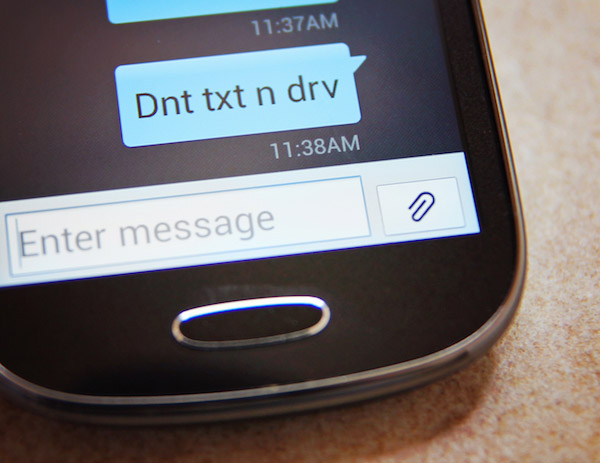April is Distracted Driving Awareness Month, An Issue that Continues to Plague U.S Roads & Highways

Original article from April 13, 2021 - Modified April 11, 2022
If you live in a major city, you are no stranger to traffic. And, with traffic comes accidents. Unfortunately distracted driving (mainly referring to texting and driving) has become the #1 problem plaguing major city freeways, streets and highways around the country.
Distracted driving is dangerous and over 3,000 lives in 2019. While 2020 was an unprecedented year due to the coronavirus (less drivers on the road), the National Highway Traffic Safety Administration (NHTSA) urges us to take precautions in 2021 (more cars returning to roads and highways).
Distracted driving, commonly referred to as “The Hangover Effect,” is a lasting mental distraction that continues up to 27 seconds after a driver uses their mobile device, even while stopped at a red light, stop sign, or while their vehicle is parked.
The NHTSA leads the national effort to save lives by preventing this dangerous behavior, and it takes all of us to keep our roads safe. You can help prevent the hangover effect simply by putting down your phone while on the road. Lives depend on it!
Distracted Driving Facts:
While we are awaiting updated statistics, here is what we know as of this writing:
1. In 2020, there were 3,142 people killed in motor vehicle crashes involving distracted drivers (even during the first year of COVID). Sadly, the statistics for 2021 and 2022 are expected to be even higher as we head into a post COVID landscape with more cars on the road.
2. Taking your eyes off the road for just 2 seconds doubles your chances of being involved in a crash.
3. Drivers using their mobile devices are up to 8 times more likely to be involved in a crash.
You can view those and other statistics In This PDF Here.
What Is Distracted Driving?
Distracted driving is any activity that diverts attention from driving, including talking or texting on your phone, eating and drinking, talking to people in your vehicle, fiddling with the stereo, entertainment or navigation system — anything that takes your attention away from the task of safe driving.
Texting is the most alarming distraction. Sending or reading a text takes your eyes off the road for 5 seconds. At 55 mph, that’s like driving the length of an entire football field with your eyes closed.
You cannot drive safely unless the task of driving has your full attention. Any non-driving activity you engage in is a potential distraction and increases your risk of crashing.
Consequences:
Using a cell phone while driving creates enormous potential for deaths and injuries on U.S. roads. In 2019, 3,142 people were killed in motor vehicle crashes involving distracted drivers.
Get Involved!
We can all play a part in the fight to save lives by ending distracted driving.
- Teens: Teens can be the best messengers with their peers, so we encourage them to speak up when they see a friend driving while distracted, to have their friends sign a pledge to never drive distracted, to become involved in their local Students Against Destructive Decisions chapter, and to share messages on social media that remind their friends, family, and neighbors not to make the deadly choice to drive distracted.
- Parents: Parents first have to lead by example — by never driving distracted — as well as have a talk with their young driver about distraction and all of the responsibilities that come with driving. Have everyone in the family sign the pledge to commit to distraction-free driving. Remind your teen driver that in states with graduated driver licensing (GDL), a violation of distracted-driving laws could mean a delayed or suspended license.
- Educators and Employers: Educators and employers can play a part, too. Spread the word at your school or workplace about the dangers of distracted driving. Ask your students to commit to distraction-free driving or set a company policy on distracted driving.
Make Your Voice Heard!
If you feel strongly about distracted driving, be a voice in your community by supporting local laws, speaking out at community meetings, and highlighting the dangers of distracted driving on social media and in your local op-ed pages.
NHTSA’s campaigns and public service announcements make the case to Americans that safe driving means driving without distractions. You’ve likely seen or heard our public service announcements, but they are also on social media sharing stories and tips to help save lives. The foundation of NHTSA’s efforts on distracted driving and other risky driving behaviors is our partnership with the states and local police. The states determine laws affecting distracted driving, but NHTSA provides federal investments in the locally driven strategies that address the states’ specific needs. To learn more about Crash Statistics click here for more info.
One of the highlights of this relationship comes during April’s Distracted Driving Awareness Month, which pairs a national advertising campaign with a law enforcement crackdown called U Drive. U Text. U Pay.
State legislatures and governors create the laws regarding distracted driving. Many states now have laws against texting, talking on a cell phone, and other distractions while driving. You can visit the Governors Highway Safety Association (GHSA) to learn about the laws in your state.
Sources:
National Highway Traffic Safety Administration (NHTSA)
Distracted Driving Overview (NHTSA)
Governors Highway Safety Association (GHSA)
Want to Learn More About Distracted Driving Awareness?
A United Agencies representative is standing by ready to help.
